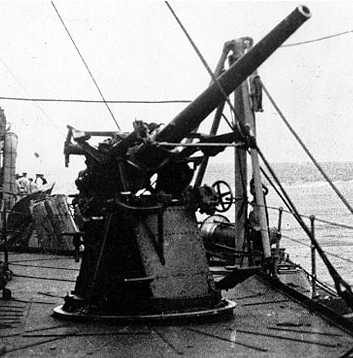
Britain's first designed-for-the-purpose AAA weapon. Developed under Royal Navy sponsorship just prior to World War I, this gun was widely used by both the Navy and the Army and was employed to protect many British cities during that conflict. First mounted afloat on HMS Iron Duke and subsequently used on most major warships and on some submarines. Replaced in the 1920s by the 4"/45 (10.2 cm) Mark V on larger warships.
During World War II this weapon was used on many destroyers in place of a set of torpedo tubes as well as on small warships and submarines.
The Mark I consisted of A tube, full length wire, jacket, breech ring, and a vertical sliding breech-block with semi-automatic action. Mark I* had different rifling. Mark IB had loose liner, full-length jacket and a removable breech ring. Mark IC was similar to IB but differed in details of the loose liner. Mark IC* was given to four guns with a muzzle bush instead of a loose liner sealing ring. There was apparently no Mark ID. Mark IE had a monobloc barrel and a screwed and shrunk breech ring. Mark SIE was a Mark IE but with the semi-automatic fittings removed, a balance weight added, a slightly different chamber and some parts were made from stainless steel, probably to allow its use on submarines. Mark II had different breech ring lugs for mounting purposes and no semi-automatic gear. Mark III was an emergency First World War design with parallel screw breech block and a two motion breech mechanism. Mark IV was similar to the Mark III but used a Welin block with an Asbury breech mechanism. Mark IVA was given to two Mark IV guns converted to use a loose liner. All marks fired fixed ammunition.
The Navy had a total of 596 Mark I, 198 Mark II, 44 Mark III and 144 Mark IV in service. Of these, 553 Mark I, 186 Mark II, 27 Mark III and 111 Mark IV remained as of September 1939.
| Designation | 3"/45 (76.2 cm) 20cwt QF HA Mark I |
|---|---|
| Ship Class Used On | World War I-era
First used on Iron Duke Many capital ships, cruisers and submarines 1913-1925 World War II-era
|
| Date Of Design | about 1910 |
| Date In Service | 1913 (as AAA) |
| Gun Weight | 2,248 lbs. (1,020 kg) |
| Gun Length oa | 143 in (3.630 m) |
| Bore Length | 135 in (3.3750 m) |
| Rifling Length | 117.5 in (2.98 m) |
| Grooves | (20) 0.0375 in deep x 0.3137 (0.953 x 7.968 mm) |
| Lands | 0.1575 in (4.001 mm) |
| Twist | Most Mark I variations: Uniform RH 1 in 30 Mark I*1: Uniform RH 1 in 40 |
| Chamber Volume | 152.9 in3 (2.51 dm3) |
| Rate Of Fire | 12 - 14 rounds per minute |
- ^The Mark I* was to be used only if absolutely necessary.
| Type | Fixed |
|---|---|
| Weight of Complete Round | The heaviest round was 28.3 lbs. (12.8 kg) |
| Projectile Types and Weights 1a | World War I HE: 12.5 lbs. (5.67 kg)
World War II HE: 16 - 17.5 lbs. (7.26-7.94 kg) |
| Bursting Charge | N/A |
| Projectile Length | N/A |
| Propellant Charge | World War I: 2.12 lbs. (0.96 kg) MD
World War II: 2.11 lbs. (0.96 kg) SC048 or 2.72 lbs. (1.23 kg) NF052 |
| Muzzle Velocity | With 12.5 lbs. (5.67 kg): 2,500 fps (762 mps)
With 16.0 lbs. (7.26 kg): 2,024 - 2,100 fps (617 - 640 mps) |
| Working Pressure | 18 tons/in2 (2,830 kg/cm2) |
| Approximate Barrel Life | 1,250 rounds |
| Ammunition stowage per gun 2a | Courageous: 150 rounds
Caledon, Ceres and Carlisle classes: 150 rounds Danae and Hawkins classes: 300 rounds Monitors of World War I: 200 rounds Others: N/A |
| Elevation | Distance |
|---|---|
| 45 degrees | 10,900 yards (9,970 m) |
| AA Ceiling (maximum) | 37,200 feet (11,340 m) |
| AA Ceiling (effective) | 23,500 feet (7,160 m) |
| Elevation | Distance |
|---|---|
| 40 degrees | 12,950 yards (11,810 m) |
| AA Ceiling (maximum) | 25,200 feet (7,680 m) |
| AA Ceiling (effective) | 15,700 feet (4,790 m) |
| Designation | AAA: HA Marks II, III and IV
Submarines: CPV |
|---|---|
| Weight | 6,310 lbs. (2,862 kg) |
| Elevation | PI: N/A (probably about -10 / +30)
HA Mounts: -10 / +90 degrees CPV: -10 / +40 (+30 in some) degrees |
| Elevation Rate | Manually operated, only |
| Train | 360 degrees |
| Train Rate | Manually operated, only |
| Gun recoil | HA Mounts/: 11 in (28 cm)
CPV: 13 in (33 cm) |
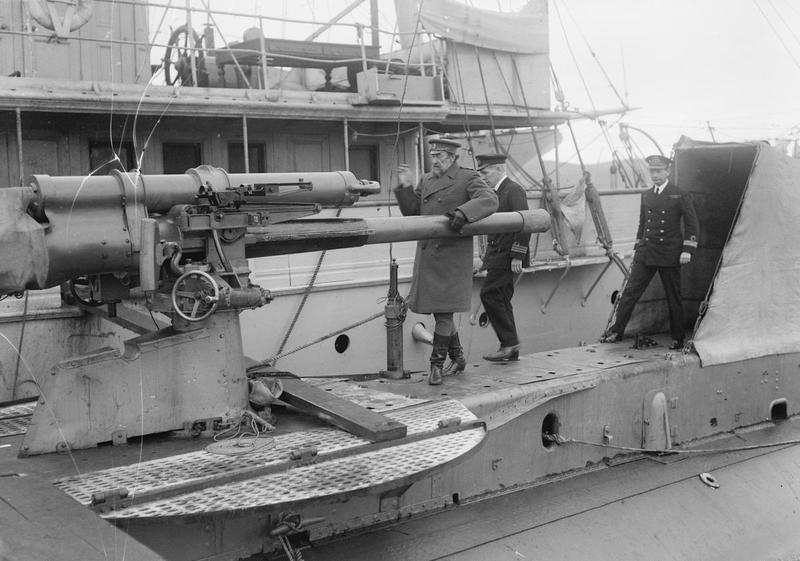
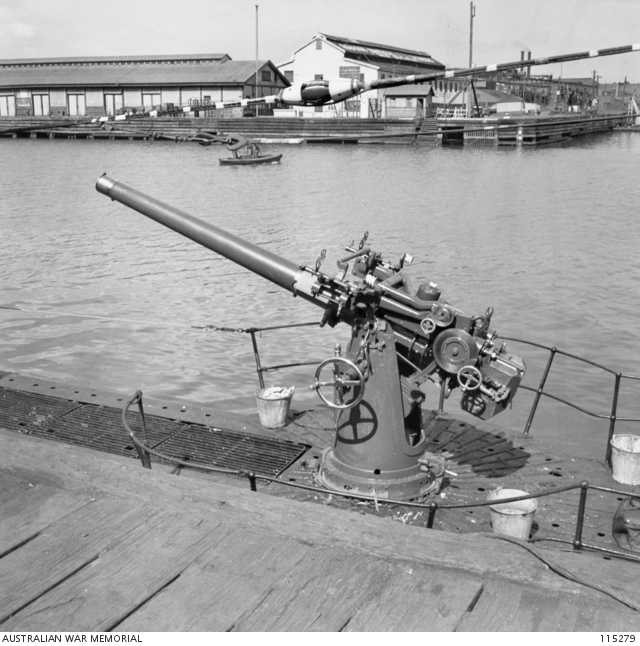

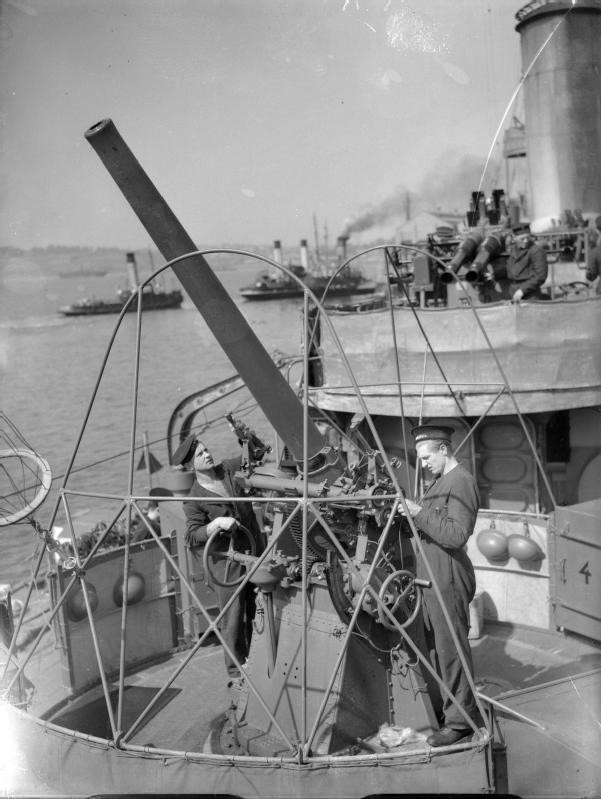
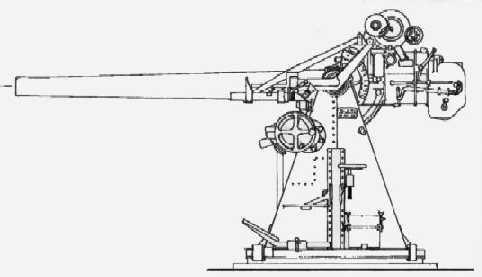
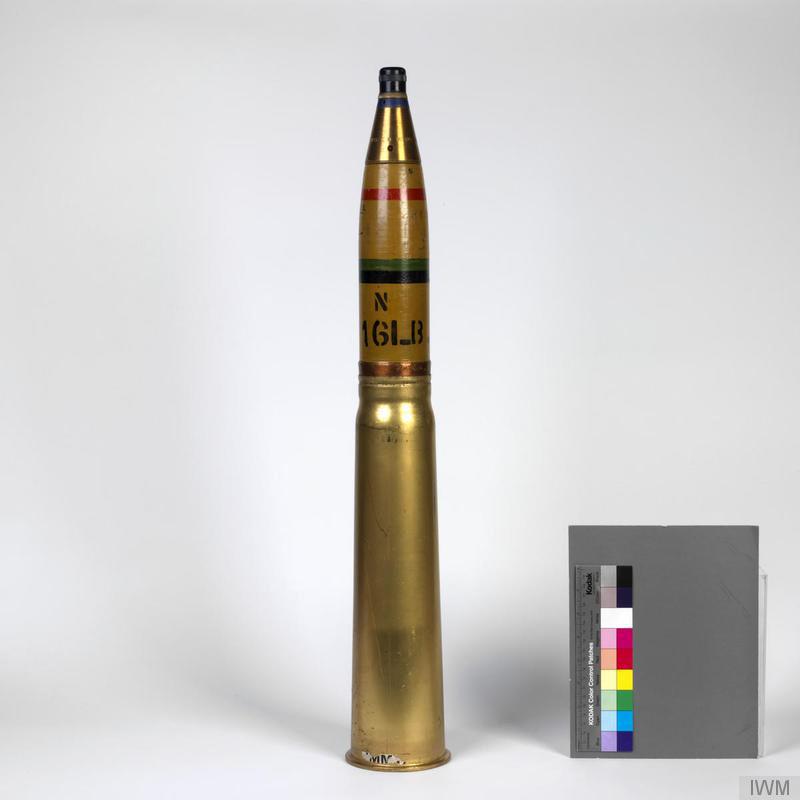
"Nelson to Vanguard: Warship Design and Development 1923-1945" by D.K. Brown
"British Battleships of World War One" by R.A. Burt
"Big Gun Monitors: The History of the Design, Construction and Operation of the Royal Navy's Monitors" by Ian Buxton
"Naval Weapons of World War Two" by John Campbell
"Destroyer Weapons of World War 2" by Peter Hodges and Norman Friedman
"The Weird Sisters" article by Keith McBride in "Warship 1990"
"British Cruisers of World War Two" by Alan Raven and John Roberts
---
Special help from John Lambert
27 February 2007 - Benchmark
12 February 2012 - Updated to latest template
15 December 2013 - Added photograph of Sunfish
16 January 2014 - Added photograph of E11
01 February 2014 - Added ammunition stowage for Dreadnought
09 September 2014 - Added photograph of Voracious
29 November 2015 - Changed Vickers Photographic Archive links to point at Wayback Archive
17 April 2021 - Updated to HTML 5 format and added photograph of Blyskawica
